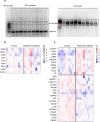This is a preprint.
Impaired Cerebrospinal Fluid Lipoprotein-Mediated Cholesterol Delivery to Neurons in Alzheimer's Disease
- PMID: 39764088
- PMCID: PMC11703344
- DOI: 10.21203/rs.3.rs-5682870/v1
Impaired Cerebrospinal Fluid Lipoprotein-Mediated Cholesterol Delivery to Neurons in Alzheimer's Disease
Update in
-
Cerebrospinal fluid lipoprotein-mediated cholesterol delivery to neurons is impaired in Alzheimer's disease and involves APOE4.J Lipid Res. 2025 Aug;66(8):100865. doi: 10.1016/j.jlr.2025.100865. Epub 2025 Jul 21. J Lipid Res. 2025. PMID: 40701521 Free PMC article.
Abstract
In the central nervous system, apolipoprotein (APO) E-containing high-density lipoprotein (HDL)-like particles mediate the transport of glial-derived cholesterol to neurons, which is essential for neuronal membrane remodeling and maintenance of the myelin sheath. Despite this, the role of HDL-like cholesterol trafficking on Alzheimer's disease (AD) pathogenesis remains poorly understood. We aimed to examine cholesterol transport via HDL-like particles in cerebrospinal fluid (CSF) of AD patients compared to control individuals. Additionally, we explored the ability of reconstituted HDL containing different APOE isoforms to regulate cholesterol transport. We evaluated the capacity of CSF HDL-like particles to facilitate radiolabeled unesterified cholesterol efflux from A172 human glioblastoma astrocytes and to deliver cholesterol to SH-SY5Y human neuronal cells. The HDL-like proteome in the AD and control groups was analyzed by liquid chromatography-mass spectrometry (LC-MS/MS). Reconstituted HDL nanoparticles were prepared by combining phospholipids and cholesterol with human APOE3 or APOE4, followed by radiolabeling with unesterified cholesterol. Our results showed that cholesterol efflux from astrocytes to CSF were similar between AD patients and controls, both under baseline conditions and after activation of ATP-binding cassette transporters A1 and G1. However, CSF HDL-like particle-mediated neuronal cholesterol uptake was significantly reduced in the AD group. LC-MS/MS analysis identified 775 proteins associated with HDL-like particles in both groups, with no major alterations in proteins linked to cholesterol metabolism. However, 27 proteins involved in non-cholesterol-related processes were differentially expressed. Notably, synthetic reconstituted HDL particles containing APOE4 exhibited reduced capacity to deliver cholesterol to neurons compared to those with APOE3. These findings indicate that CSF HDL-like particles from patients with AD demonstrate impaired cholesterol delivery to neurons. Our study highlights APOE4 as a critical contributor to abnormal neuronal cholesterol uptake in AD pathophysiology.
Keywords: APOE; Alzheimer's Disease; Cholesterol; HDL-like lipoprotein.
Figures



References
-
- Alcolea D, Clarimón J, Carmona-Iragui M, Illán-Gala I, Morenas-Rodríguez E, Barroeta I et al. (2019) The Sant Pau Initiative on Neurodegeneration (SPIN) cohort: A data set for biomarker discovery and validation in neurodegenerative disorders. Alzheimer’s Dement Transl Res Clin Interv 5:597–609. 10.1016/J.TRCI.2019.09.005 - DOI - PMC - PubMed
Publication types
Grants and funding
LinkOut - more resources
Full Text Sources
Miscellaneous

